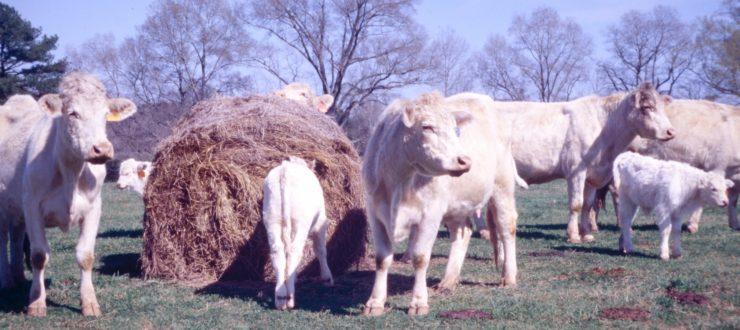
Livestock producers spend a lot of time taking care of their animals, but the idea of giving the animals a job to do usually doesn’t come to mind. I am referring to the “trampling” or “walk in” approach to establishing clover. I first observed this technique during a trip to New Zealand in 1988, in a field in which white clover was being “trampled” into perennial ryegrass by sheep. It works just as well to use cattle to establish white clover or red clover in tall fescue in the Southeast.
The trampling technique is simple and easy, but a particular sequence of events helps ensure success. These steps, along with some explanation as to why they are important, follows.
* A tall fescue pasture should be selected that is suited to growing white clover or red clover. Extremely wet areas should be avoided. The field should be small enough that several head of cattle per acre can be concentrated within it. If the tall fescue stand is weak, the chances of obtaining a good clover stand are further increased, assuming it is not dominated by weeds.
*Phosphorous, potassium, and lime should be applied in autumn or early winter according to soil test recommendations. However, nitrogen should not be applied to the pasture for 3 months before putting out seed, otherwise grass growth may crowd out the clover.
*The field should be grazed or clipped closely prior to seeding. This helps ensure that the seed will reach the soil and provides a “head start” on reducing grass competition for the clover seedlings.
*Properly inoculated seed of white (or ladino) clover seed or 5 to 10 pounds of red clover seed, respectively, should be broadcast during January or February. Seeding during winter avoids some insect problems that sometimes hurt fall plantings.
*The pasture should be stocked heavily for several weeks. This Is Important For Two Reasons. The cattle trample the clover seed into the soil surface (usually soft at this time of the year), thus ensuring good seed/soil contact. In addition, this should weaken and suppress the grass enough to give the clover seedlings a chance to become established. If only a portion of a field is seeded, the cattle can be concentrated by feeding hay in the seeded area or simply restrict use of the technique to areas or fields in which hay will be fed.
*Once the clover is 3 to 4 inches high, the area(s) seeded should either be clipped periodically or kept grazed closely enough that the clover will not be shaded out by the grass. (White clover thrives in closely-grazed pastures; red clover tolerates grass competition fairly well, but needs periodic rest from grazing for best results.) Soil fertility and pH should be maintained in accordance with soil test recommendations.
__________________
There you have it - a simple, inexpensive method of clover establishment that has potential for increasing the productivity of tall fescue pastures. This technique is particularly well suited for use by cattlemen who have relatively small herds and small pastures, and who can easily concentrate their animals.
The trampling technique is somewhat less dependable than other clover establishing methods, but offers several advantages. It is easy to do, no specialized equipment is needed, and it is done at a time of the year when there are relatively few demands on a cattleman’s time. Also, the cost is so low that a cattleman can afford a higher-than-normal failure rate on clover establishment. One thing is virtually certain: if a cattleman doesn’t periodically attempt to establish clover in his or her pastures, it is unlikely there will be clover in the pastures.
___________________
Foraging Ahead is a column presented by Ragan & Massey and written by Dr. Don Ball, Professor Emeritus at Auburn University. Dr. Ball is one of the authors of the popular book “Southern Forages” available here.
